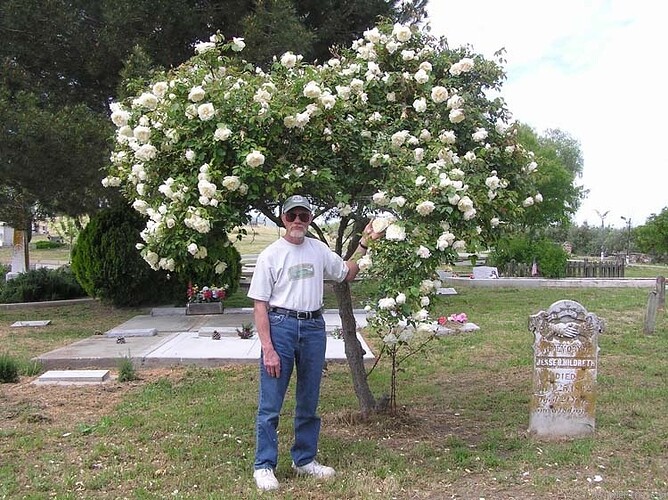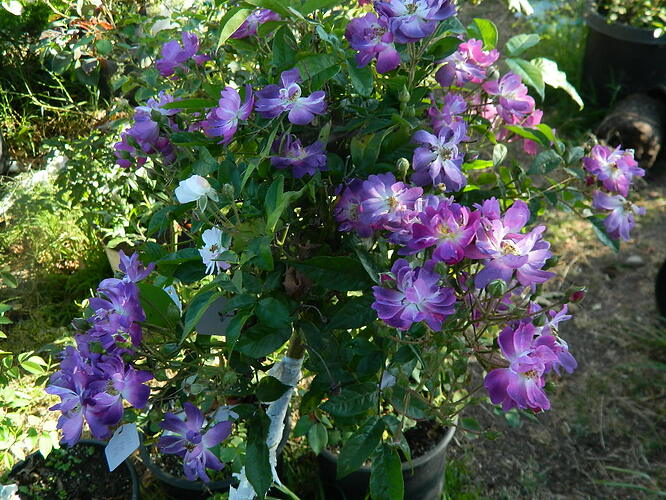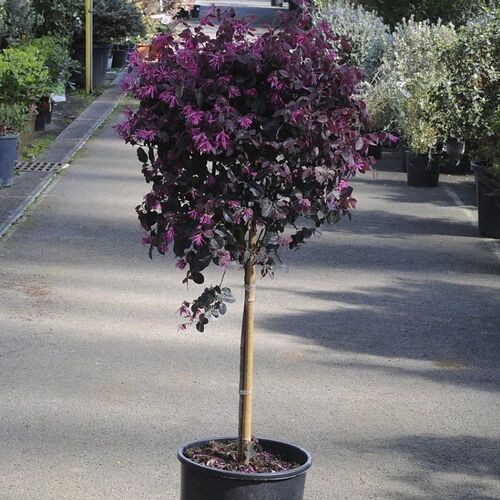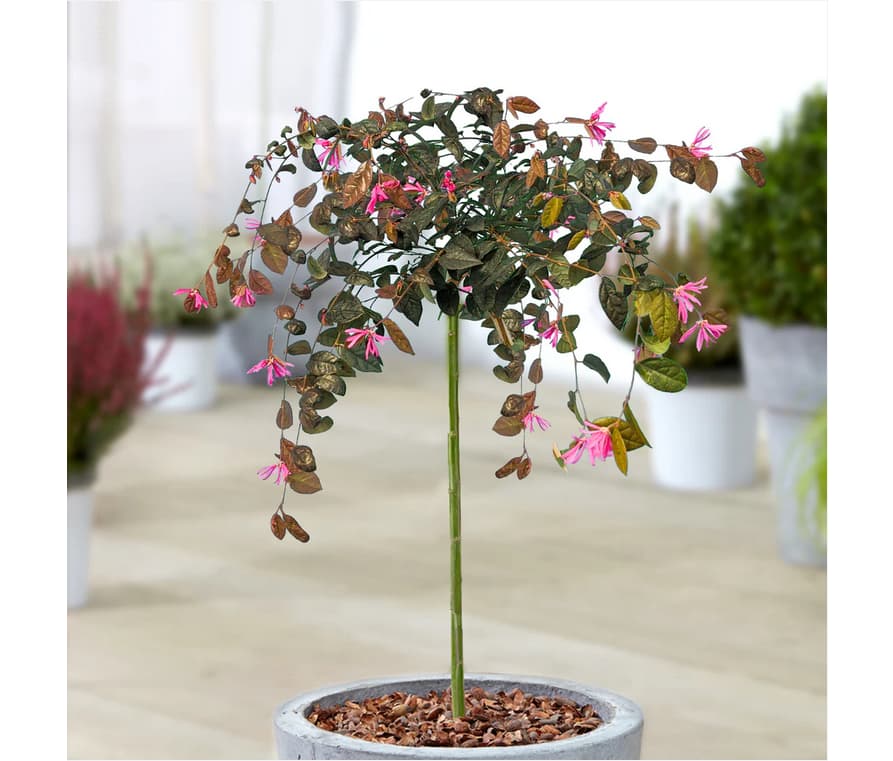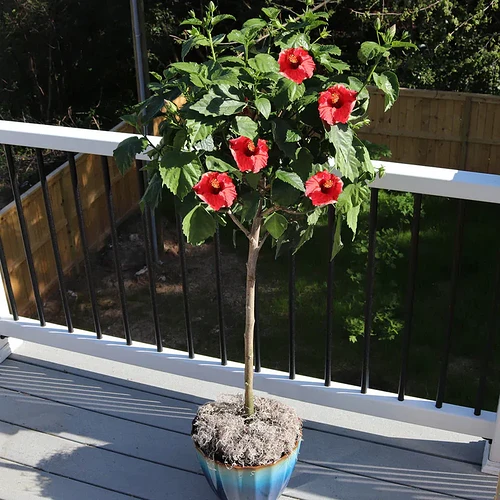Would “rosa macrophylla master hugh” be a good starting point for the large rose hips? I was also wanting to add in “Lady banksia” for the size of the plant. Id like for the hybrid to be ever blooming and very fragrant as i like the smell of flowers but have a poor sense of smell. Id like to make dishes and drinks with the rose petals and rose hips.
Welcome! Nice ideas, but Banksiae has TINY hips with virtually no flesh. It’s also very difficult to get any vigor out of many of its hybrids. Generating hybrids is not an easy task and getting it to cross with Master Hugh is likely to take a LONG time and result in somewhat less than your ideal.
Look for the rose Cl Winifred Coulter. 'Winifred Coulter Cl.' Rose It is a large, repeat flowering climbing floribunda with HUGE hips. Orangeade 'Orangeade ®' Rose also makes huge hips. When my nephews were small, their dad would carve the Halloween pumpkins and they wanted to help. Being too small to allow them to touch knives, I would bring over a bag of these two hips for us to paint them as Halloween decorations. For taste, the Ralph Moore rose, Sharon’s Delight, 'Sharon's Delight™' Rose has sweet tasting hips. Most rose hips I’ve tasted, and I HAVE tasted many in hopes of finding those which had a desirable taste, aren’t very good.
All three of these are modern roses with continuous bloom spring through fall and the first two are VERY fertile. The third sets hips but little of any benefit germinates from the seed so I’d use it for pollen. Unfortunately, none of them is “very fragrant” but who knows what you might raise from pimping some of their pollen? Good luck!
Thanks ![]() i didnt realize lady banskia wasnt good for hybridizing. Ill have to look more into the rose species and cultivars i guess. I am new to roses. I am in the reserch phase and havent bought any yet. Id like to try and breed them when i get them tho.
i didnt realize lady banskia wasnt good for hybridizing. Ill have to look more into the rose species and cultivars i guess. I am new to roses. I am in the reserch phase and havent bought any yet. Id like to try and breed them when i get them tho.
You’re welcome. Check out R. Villosa, also known as “The Apple Rose”. 'R. villosa' Rose There is also a hybrid Rugosa released a decade or so ago called Sweet Hips 'Sweet Hips' Rose . They are reportedly large and have a decent flavor. I’ve not grown it so I can’t attest to any of that.
Thanks ill check out those ![]() im in central texas. I saw that regusa can be invasive further north along the beaches would it be in centra texas?
im in central texas. I saw that regusa can be invasive further north along the beaches would it be in centra texas?
I just saw in a different thread you bred minufolia in the past. Is it something that can be bred into a rose bonsai form? Im interested in bonsai also and have seen rose bonsais online.
Perhaps you can try R. roxburghii normalis. Their large, yellow, thorny hip is served as traditional food in some regions of China, called “thorny pear”, mainly for juice. One of its offspring, R. sterilis (R. longicuspis × R. roxburghii), is also used. I heard that its related species, R. hirtula, is used in some snacks in Japan.
Thanks those look nice. I like the tree like ones. Its why i was wanting a lady banskia but they are more climbers ive found out.
Own root, where it will grow and in soil less “heavy” than total clay, Rugosa will help itself to every available square inch. My experience is it HATES high heat, aridity and alkaline clay soils. It’s also more successful in shorter season climates as opposed to our “land of endless summer” where the length of time the foliage remains sufficiently juvenile and healthy doesn’t end before the growing season. In that situation, healthy Rugosa will rust and black spot until something knocks all of the nasty, senile foliage off it.
The only way to use Minutifolia as a bonsai is to severely prune it. I don’t know how cooperative it would be as I don’t “prune” it. In Nature, fires prune it. Otherwise, it just keeps growing, and in my coastal California climate, it simply continues to flower. If you want a rose bonsai, select whatever mini you find the foliage and flower size appropriately attractive and work with that. Minis are much more cooperative to being “tortured”.
I forgot to include, the tiny foliage is overwhelmed by the “rose” foliage so you lose the very tiny leaves in favor of “rose foliage”. The smallest foliage I’ve been able to coax out of it in in the Tom Thumb cross. 'L56Min2TT' Rose Who knows what might result from raising the self set seed? There have been too many other things to occupy me than this.
Thanks ill look up some miniatures for the bonsai. Im also raising pepper seeds for bonsai i got this winter when it warms up. The peppers are called bonchi when its bonsai.
My aunt has a variety called old blush i think she said. She said i can have some cuttings off of hers. What would that be good to breed with for practice? And also do you have suggestions for using helpmefind.com i got the premium account but it has a lot to take in lol.
Sure, why not? Anything that sets viable seeds is worth practicing with. Suggestion: look up Old Blush. Click on the “Lineage” tab to see what’s known about what may be behind it. Then, click on “Descendants by Generation” to see what’s been bred from it. You can also click on “Sports” under “Lineage” to see what it mutated to. Remember, you can then click on any results the database shows you to see all there is in it about each one of those to discover everything entered in the database about all of them. And, each page you access, will allow you to discover the same information about each of those. You’ll have a ball!
Oh ok i was reading about old blush and its one of the original roses from back in the day lol. Ill have to do some more reading about various types. I was wanting something that is self supporting and tall kind of like the tombstone rose tree but not supported.
Many OGRs can be tortured into that kind of shape and size. Jesse Hildreth, a found Tea from the San Juan Bautista Cemetery in California was tortured into something like that. Re propagated and allowed to grow as it wishes, it’s nothing like that growth. A dear friend, Jeri Jennings, took this photo of it and posted it to HMF.
If your climate supports it, many old Teas can achieve such proportions. This is Niles Cochet, also grown in San Juan Bautista, where there once was a house or business. The climate supported this growth until too many years of drought when citizens had to begin supplementing the water. Another of Jeri’s photos from HMF.
So, there are roses which will achieve these kinds of proportions free standing, but only in climates and conditions which support it. For “tree-like” growth, you probably want R. Hirtula. 'R. hirtula' Rose It is grown in the US but not easily obtained unless you make the acquaintance of someone who has a happy plant of it. I don’t know if it would be useful creating the food source you want, but that’s the closest to the tree growth you seek.
Thanks so i guess ill have to train the roses how i want them then? Makes sense. Ill keep an eye out for that cultivar thanks ![]() and the others y’all have mentioned.
and the others y’all have mentioned.
How would you train a rose into that tree form, with a trunk and branches? I like that, as instead of sprawling at ground level, it makes the most of vertical space and leaves space below for small flowering plants.
Could I do that with Reine des Violettes?
It would require the same training as is done for single shoot standards of all the florist potted “tree” azaleas, hydrangeas, camellias, etc. Look at the five gallon patio standards of many popular shrubs: Lorepetalum, Melaleuca, Bougainvillea, Hibiscus and others. You have to select the strongest shoot and prune away everything else. Disbud the length of that main shoot, only allowing the top two or three shoots to remain. The goal is to push new growth from the terminal bud to produce a straight, tall trunk and only allowing lateral growth from the top buds to produce a bushy head. Reine des Violettes may require special attention as it wants to push those long, stiff canes straight up.
Victorian and Edwardian florists did this with rambling and climbing roses to produce flowering topiaries for sale during winter holiday periods. I did similarly with long rooted whips of IXL and Pink Clouds to use as standard stocks upon which to bud other scions. By removing the side buds and only allowing the top two or three to remain, then continually pinching back those shoots as they push new long growth, it results in a bushy head which you can shape as desired. When the weather conditions support it, flower buds will be produced all over the surface, resulting in a lollipop of those blooms. This is the best image I have of the results. I didn’t take it to illustrate the principal but to document what I was using to breed on.
If you start with an established plant, you will continually have to keep chopping out “suckers” from the crown of the plant. Rooting a cutting from the top of a shoot so it contains the terminal growth which would continue growing straight up would provide you with a better “trunk”.
The Jesse Hildreth “tree” was produced accidentally by continuing to remove all the basal growth from the bush over many years. All the resources were focused on the remaining shoot until it produced that strong, thick trunk. Unfortunately, its life is finite and it began to age rather badly. It appeared the plant was dying and they continued to remove the new replacement basals until someone finally got through to the “maintenance” people to stop doing it. New shoots exploded from the base in fresh, gorgeous growth which smothered itself in blooms. A rather unfortunate encounter with Round Up over spray nearly finally killed the plant but it has rebounded and is now under the protection of several members of the local rose interest group.
These images were “borrowed” from the Net to illustrate the patio standards. They will always require staking to prevent the trunk from being broken by the wind.
Lorepetalum
Or, un pruned to allow for the natural weeping growth.
Hibiscus standard
You can achieve similarly with a rose as long as it produces long, straight growth. For the shorter, bushier types, you have to bud them to a rooted whip of a climber, which is the standard production method of producing “tree roses”.
Thats interesting and a lot of great info ![]() ill have to try that out. Was the tombstone “rose tree” pruned that way also?
ill have to try that out. Was the tombstone “rose tree” pruned that way also?
No, it was grown up through a roof trellis so it spreads out over a large support “roof” as some people grow grapes. So the roof was like a huge, flat umbrella. I guess you COULD treat a Banksiae this way but it would require constant grooming as they can produce several feet of growth in a few weeks. I have seen Banksiae grown against a two story house wall, kept tightly clipped where it formed about an 18" thick green wall covering. The poor gardener was there weekly solely to attend to the Banksiea. When it flowered, it was a literal wall of yellow. Sadly, that was in Pacific Palisades and if the Banksiae still lived, it’s gone now. The HOA in the community where my old Newhall garden existed used Banksiae as hillside shrubs. The poor ground guy had to machete them every two weeks to keep them “neat” or the clueless person in charge of the “landscape committee” had kittens.

